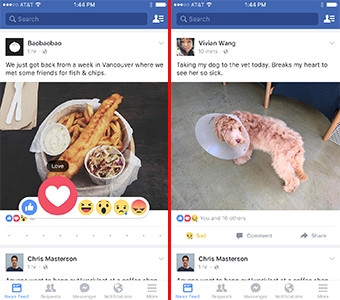
Social media giant Facebook will today roll-out its long-awaited 'reactions' feature. Users will now have a choice of five different emotions when responding to posts, instead of just the 'like' button.
Last year, Facebook CEO Mark Zuckerberg said people had been asking for a dislike button for years, as 'liking' is not always appropriate. "It's important to give people more options than just 'like' to help express empathy and sympathy. Not every moment is a good moment," said the CEO.
Instead of simply adding a 'dislike' button, the company decided to give users the option of six different reactions: 'love' represented by a heart, 'haha' by a laughing emoji, yay by a smiling emoji, wow by a surprised emoji, sad by a crying emoji, and angry by a red-faced emoji.
This feature was tested in seven countries: Spain, Ireland, Portugal, the Philippines, Chile, Japan and Columbia.
These countries were chosen because: "Facebook has a large global community and we wanted to make sure that when we launched this feature, it would be useful to everyone," said product manager Sammi Krug in an interview with ITWeb. "We really wanted to make sure that the reactions we were launching were universally understood."
For this reason, after a year of testing, the 'yay' reaction was dropped. "Yay was cut in the end as the studies found it was too vague and people were not clear when to use it," says Krug.
How it works
To add a reaction, users hold down the like button on mobile or hover over the like button on desktop to see the reaction image options, then tap either like, love, haha, wow, sad, or angry. A summary of how people are reacting to posts will appear underneath the post.
Reactions will be available to iOS and Android users running the latest version of the Facebook app.
All posts in Facebook's news feeds, including posts by Pages and businesses, will support this new feature. "I think this is going to be a really exciting moment for publishers of Pages and businesses because reactions will give them the opportunity to understand how their posts are resonating with the people they are trying to reach," says Krug.
Page Insights will also be revamped to give publishers and brands better metrics of how their audience is reacting to their content.
Slow connection?
The reaction buttons, when they appear, will be animated emoji. However, if it is identified that the device is using a slow connection, the emoji will not move.
"One of the things that Mark and our engineering team felt really strongly about was making sure this works really well on all the different devices that we support," said Krug.
"So to that effect, animations will roll-out on most iOS and most Android devices; however, if we detect that you are on a device where this could potentially have a negative impact on it, we do not animate and the reactions will be static, to make sure it is a good experience no matter your connection or device."
Share